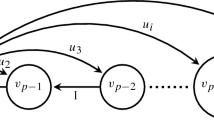Abstract
A new class of matrices is introduced for use in error control coding. This extends previous results on the class of Fibonacci error correcting codes. For a given integer p, a (p+1)×(p+1) binary matrix M p is given whose nonzero entries are located either on the superdiagonal or the last row of the matrix. The matrices \({M^{n}_{p}}\) and \(M^{-n}_{p}\), the nth power of M p and its inverse, are employed as the encoding and decoding matrices, respectively. It is shown that for sufficiently large n, independent of the message matrix M, relations exist among the elements of the encoded matrix \(E=M\times {M_{p}^{n}}\). These relations play a key role in the error detection and correction.
Similar content being viewed by others
References
Stakhov, A.P.: Introduction into Algorithmic Measurement Theory. Soviet Radio, Moscow (1977). [in Russian]
Hoggat, V.E.: Fibonacci and Lucas Numbers. Houghton-Mifflin, Palo Alto (1969)
Gould, H.W.: A history of the Fibonacci Q-matrix and a higher-dimensional problem. Fibonacci Quart. 19(3), 250–257 (1981)
Stakhov, A.P.: A generalization of the Fibonacci Q-matrix. Rep. Natl. Acad. Sci. Ukraine 9, 46–49 (1999)
Stakhov, A., Massingue, V., Sluchenkov, A.: Introduction into Fibonacci Coding and Cryptography. Osnova, Kharkov (1999)
Stakhov, A.P.: Fibonacci matrices, a generalization of the Cassini formula and a new coding theory. Chaos, Solitons and Fractals 30(1), 56–66 (2006)
Basu, M., Prasad, B.: The generalized relations among the code elements for Fibonacci coding theory. Chaos, Solitons and Fractals 41(5), 2517–2525 (2009)
Cahill, N.D., D’Errico, J.R., Spence, J.: Complex factorisations of the Fibonacci and Lucas numbers. Fibonacci Quart. 41(1), 13–19 (2003)
Esmaeili, M., Esmaeili, M.: Polynomial Fibonacci-Hessenberg matrices. Chaos, Solitons and Fractals 41(5), 2820–2827 (2009)
Esmaeili, M., Esmaeili, M.: A Fibonacci-polynomial based coding method with error detection and correction. Comput. Math. Appl. 60(10), 2738–2752 (2010)
Esmaeili, M., Esmaeili, M., Gulliver, T.A.: High-rate Fibonacci polynomial codes. In: Proceedings of IEEE International Symposium on Information Theory, pp 1921–1924, St. Petersburg (2011)
Acknowledgments
The authors would like to thank the anonymous referees for their constructive comments.
Author information
Authors and Affiliations
Corresponding author
Appendix
Appendix
This appendix provides a proof of the existence of a unique real solution for the system of equations given by (28). By setting u = α 1 α 2⋯α p , the system of equations given by (28) is changed to
so that in general
It follows from \(\frac {1}{\alpha _{1} \alpha _{2} {\cdots } \alpha _{p}}= 1+u+u^{2}+{\cdots } +u^{p}\) that \(\frac {1}{u}= 1+u+u^{2}+{\cdots } +u^{p}\) and hence u ≠ 1. From
we have that
This results in
and hence
A real solution for this equation is u = 1 which is not acceptable as mentioned above. For an even number p, the function y 1(u) = u p+2 is concave, and the two functions y 1(u) = u p+2 and y 2(u) = 2u−1 are equal at u = 1 and a number in (0, 1), so the latter is the desired solution. If p is odd, y 1(u) = u p+2 is negative for u < 0, and y 1(u) = u p+2 and y 2(u) = 2u−1 intersect at u = 1, a number in (0,1) and a number in \((-\infty , 0)\). As the α i are positive, a negative solution for (28) is not acceptable, so (28) has a unique real solution. This argument provides the following method for solving (28). First find a real solution for u p+2−2u+1=0 in the interval (0,1), and then compute α k by making use of \(\alpha _{k}=\frac {u^{k}-1}{u^{k+1}-1}\).
Rights and permissions
About this article
Cite this article
Esmaeili, M., Moosavi, M. & Gulliver, T.A. A new class of Fibonacci sequence based error correcting codes. Cryptogr. Commun. 9, 379–396 (2017). https://doi.org/10.1007/s12095-015-0178-x
Received:
Accepted:
Published:
Issue Date:
DOI: https://doi.org/10.1007/s12095-015-0178-x




